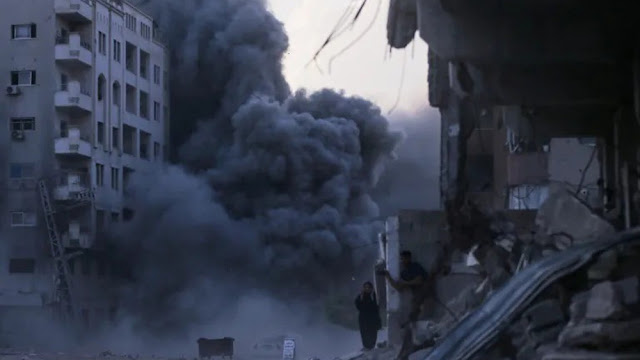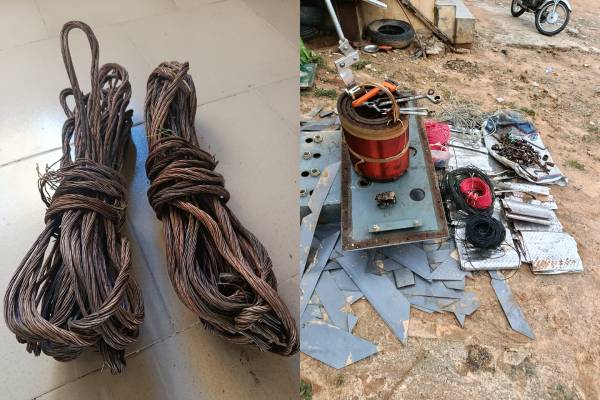Palestinians take cover during an Israeli strike on a building in Gaza City, on September 7, 2025. (AP photo)
On September 8, 2025, the Palestinian resistance movement Hamas confirmed that it had received a set of ideas from American mediators aimed at brokering a ceasefire in the ongoing Gaza conflict. The announcement, made through a statement by Hamas, underscores the latest diplomatic efforts to halt the violence that has gripped the region for nearly two years, claiming thousands of lives and displacing countless others. While the details of the U.S. proposals remain undisclosed, Hamas indicated that it is reviewing the suggestions and will respond once its evaluation is complete. This development comes as international pressure mounts to find a resolution to the devastating war, which has drawn global condemnation for its humanitarian toll.
Background: The Gaza Conflict and the Quest for Peace
The Gaza Strip, a densely populated enclave on the eastern Mediterranean coast, has been a flashpoint of conflict between Israel and Palestinian groups, particularly Hamas, for decades. The latest escalation, which began in October 2023, has been one of the deadliest chapters in the Israeli-Palestinian conflict. Sparked by a surprise attack by Hamas on Israeli territory, the war has seen relentless Israeli airstrikes and ground operations in Gaza, countered by rocket barrages and guerrilla tactics from Palestinian fighters. According to the Gaza Health Ministry, over 40,000 Palestinians have been killed, with tens of thousands more injured, and much of the enclave’s infrastructure lies in ruins. Israel, meanwhile, reports significant casualties and ongoing security concerns.
The humanitarian crisis in Gaza has reached catastrophic levels. Over 1.9 million people—nearly the entire population of the territory—have been displaced, with many living in makeshift shelters or overcrowded camps. Access to food, clean water, and medical supplies is severely limited, and the United Nations has warned of an impending famine. International organizations, including the International Committee of the Red Cross and Médecins Sans Frontières, have repeatedly called for an immediate ceasefire to allow humanitarian aid to reach those in need.
Efforts to broker a ceasefire have been ongoing since the conflict’s outset, with Egypt, Qatar, and the United States playing key roles as mediators. However, previous rounds of negotiations have collapsed due to disagreements over key issues, including the withdrawal of Israeli forces from Gaza, the release of hostages, and the terms of a long-term truce. The involvement of the United States, a key ally of Israel, has often been met with skepticism by Palestinian groups, who accuse Washington of bias. Nonetheless, the latest U.S. proposals signal a renewed push to end the violence and address the humanitarian catastrophe.
Hamas’s Response to the U.S. Proposals
In its statement on September 8, 2025, Hamas confirmed that it had received what it described as “ideas” from American mediators through intermediaries, likely Egypt or Qatar. The movement, which governs Gaza and leads the Palestinian resistance against Israeli occupation, did not disclose specific details of the proposals, citing the need for internal deliberations. “We are studying the ideas carefully and will provide our response once we have completed our review,” the statement read. This cautious approach reflects Hamas’s long-standing practice of consulting its leadership and allied factions before committing to diplomatic initiatives.
Analysts suggest that the U.S. proposals likely include a framework for a temporary ceasefire, possibly tied to the release of hostages held by Hamas in exchange for Palestinian prisoners detained by Israel. Such an exchange has been a cornerstone of previous ceasefire talks, with both sides expressing willingness to negotiate on this point. However, Hamas has consistently demanded a complete Israeli military withdrawal from Gaza and an end to the blockade that has restricted the flow of goods and people since 2007. Israel, on the other hand, insists on security guarantees, including the disarmament of Hamas and other armed groups, a condition the resistance movement has rejected outright.
The timing of the U.S. proposals is significant. With the U.S. presidential election approaching in 2025, the administration of President Joe Biden is under pressure to demonstrate progress in resolving the Gaza conflict, which has strained Washington’s relations with Arab allies and sparked protests domestically. The Biden administration has faced criticism for its unwavering support for Israel, including billions of dollars in military aid, even as the humanitarian crisis in Gaza worsens. By presenting new ideas for a ceasefire, the U.S. appears to be seeking a diplomatic breakthrough that could bolster its image as a peacemaker.
The Role of International Mediators
The Gaza conflict has drawn intense international attention, with multiple countries and organizations attempting to mediate a resolution. Egypt and Qatar have been at the forefront of these efforts, leveraging their regional influence and relationships with both Hamas and Israel. Egypt, which shares a border with Gaza, has hosted several rounds of ceasefire talks in Cairo, while Qatar has used its financial clout and diplomatic channels to facilitate negotiations. Both countries have a vested interest in stabilizing the region, as the conflict risks spilling over into neighboring areas, including Egypt’s Sinai Peninsula and the broader Middle East.
The United States, while not a direct mediator in the same way as Egypt or Qatar, plays a pivotal role due to its influence over Israel and its status as a global superpower. Washington has historically shaped the trajectory of Israeli-Palestinian negotiations, from the Oslo Accords in the 1990s to the Camp David talks in 2000. However, its credibility as an impartial mediator has been questioned by Palestinian groups, who point to the U.S.’s consistent support for Israel, including its veto power at the United Nations Security Council to block resolutions critical of Israeli actions.
The latest U.S. proposals, delivered through intermediaries, suggest a continuation of this indirect approach. Rather than engaging Hamas directly—something the U.S. avoids due to its designation of the group as a terrorist organization—Washington is working through regional partners to communicate its ideas. This strategy allows the U.S. to maintain its stance against Hamas while still participating in the diplomatic process.
Challenges to a Ceasefire
Despite the renewed diplomatic push, significant obstacles remain to securing a ceasefire. One of the primary challenges is the deep mistrust between the parties. Hamas accuses Israel of violating previous agreements and using ceasefire talks as a pretext to continue its military operations. Israel, meanwhile, views Hamas as an existential threat and is reluctant to make concessions that could strengthen the group’s position in Gaza. This mutual suspicion has derailed past negotiations and could complicate the current efforts.
Another sticking point is the issue of Gaza’s reconstruction. The war has caused unprecedented destruction, with entire neighborhoods reduced to rubble and critical infrastructure, such as hospitals and schools, heavily damaged. Rebuilding Gaza will require billions of dollars in international aid, as well as agreement on how reconstruction funds will be managed. Hamas has called for the lifting of the Israeli-Egyptian blockade to allow construction materials and other goods to enter the territory, but Israel fears that such materials could be diverted for military purposes.
The plight of hostages and prisoners further complicates the negotiations. Hamas is believed to be holding dozens of Israeli hostages, including civilians and soldiers, captured during the October 2023 attack. Israel, in turn, holds thousands of Palestinian prisoners, many of whom are detained without charge under administrative detention laws. Any ceasefire deal is likely to include a swap, but the specifics—such as the number of prisoners to be released and the conditions of their release—remain contentious.
International pressure is another factor shaping the talks. The United Nations, European Union, and several Arab states have called for an immediate ceasefire and an end to the blockade, arguing that the humanitarian crisis in Gaza demands urgent action. However, Israel’s security concerns and Hamas’s insistence on maintaining its military capabilities create a complex web of competing interests that mediators must navigate.
The Humanitarian Crisis in Gaza
The war in Gaza has unleashed a humanitarian disaster of staggering proportions. The Gaza Health Ministry reports that over 40,000 Palestinians have been killed since October 2023, with the majority being civilians, including women and children. The actual death toll may be higher, as many bodies remain unrecovered beneath the rubble. Hospitals, overwhelmed by the influx of wounded, are operating at a fraction of their capacity due to shortages of medical supplies and fuel for generators. The World Health Organization has warned of the spread of infectious diseases, exacerbated by poor sanitation and overcrowding in displacement camps.
The blockade, imposed by Israel and Egypt since Hamas took control of Gaza in 2007, has compounded the crisis. Restrictions on the movement of goods and people have crippled the economy, leaving over half of Gaza’s population unemployed and dependent on aid. The destruction of farmland and fishing boats has further eroded food security, with many families surviving on minimal rations. The United Nations Relief and Works Agency (UNRWA), which provides essential services to Palestinian refugees, has struggled to meet the growing demand for assistance amid funding shortages and attacks on its facilities.
Children have been particularly hard-hit by the conflict. UNICEF estimates that over 14,000 children have been killed, and thousands more have been injured or orphaned. Schools have been shuttered, with many converted into shelters or destroyed in airstrikes. The psychological toll on Gaza’s youth is immense, with reports of widespread trauma and anxiety among children exposed to relentless violence.
The Broader Geopolitical Context
The Gaza conflict does not exist in isolation but is part of a broader geopolitical struggle in the Middle East. Israel’s actions in Gaza are closely watched by its neighbors, particularly Iran, which supports Hamas and other Palestinian factions. Tehran has condemned Israel’s military campaign and called for greater international pressure to end the war. At the same time, Israel accuses Iran of fueling the conflict by providing weapons and funding to Hamas, a charge Iran denies.
The war has also strained Israel’s relations with Arab states that have normalized ties through the Abraham Accords, including the United Arab Emirates and Bahrain. While these countries have maintained diplomatic relations with Israel, public opinion in the Arab world remains strongly supportive of the Palestinian cause, putting pressure on their governments to take a firmer stance against Israel’s actions.
For the United States, the Gaza conflict poses a delicate balancing act. Washington’s support for Israel is a cornerstone of its Middle East policy, but the humanitarian crisis and growing anti-Israel sentiment globally have complicated this relationship. The Biden administration has sought to thread the needle by reaffirming its commitment to Israel’s security while calling for restraint and humanitarian access. The latest ceasefire proposals are part of this effort to project a more balanced approach, though their success remains uncertain.
Potential Outcomes and the Path Forward
As Hamas reviews the U.S. proposals, several potential outcomes are possible. The most optimistic scenario is that the ideas form the basis for a temporary ceasefire, allowing humanitarian aid to flow into Gaza and paving the way for further negotiations. Such an agreement could include a hostage-prisoner swap and a pause in hostilities, providing much-needed relief to Gaza’s beleaguered population.
However, even a temporary ceasefire would likely be fragile, as both sides have deep-seated grievances and conflicting long-term goals. Hamas seeks an end to the occupation and the establishment of a Palestinian state, while Israel prioritizes its security and the neutralization of Hamas’s military capabilities. Bridging these divides will require sustained diplomatic engagement and concessions from both parties—prospects that seem distant given the current level of animosity.
A more pessimistic scenario is that the talks falter, as previous efforts have, leading to a continuation of the violence. This would exacerbate the humanitarian crisis and further isolate Israel diplomatically, while strengthening Hamas’s resolve to resist through armed struggle. The international community, particularly the United States, would face growing criticism for its inability to secure a resolution.
In the longer term, a lasting solution to the Gaza conflict will require addressing the root causes of the Israeli-Palestinian conflict, including the occupation, the status of Jerusalem, and the right of return for Palestinian refugees. These issues, however, are deeply divisive and have defied resolution for decades. For now, the focus remains on achieving a ceasefire to halt the immediate bloodshed and alleviate the suffering in Gaza.
Conclusion
The announcement that Hamas has received ceasefire proposals from American mediators marks a significant, if cautious, step toward ending the devastating war in Gaza. While the details of the proposals remain under wraps, their introduction signals a renewed diplomatic effort to address one of the most pressing humanitarian crises of our time. As Hamas deliberates its response, the world watches closely, hoping for a breakthrough that could bring relief to the people of Gaza and a measure of stability to the region.
The road to peace, however, is fraught with challenges. Mistrust, competing interests, and the sheer scale of the destruction in Gaza pose formidable obstacles to a lasting agreement. The international community, led by mediators like Egypt, Qatar, and the United States, must navigate these complexities with patience and determination. For the people of Gaza, who have endured unimaginable hardship, the stakes could not be higher. Whether the U.S. proposals will lead to a meaningful ceasefire or yet another missed opportunity remains to be seen, but the urgency of finding a resolution has never been greater.






